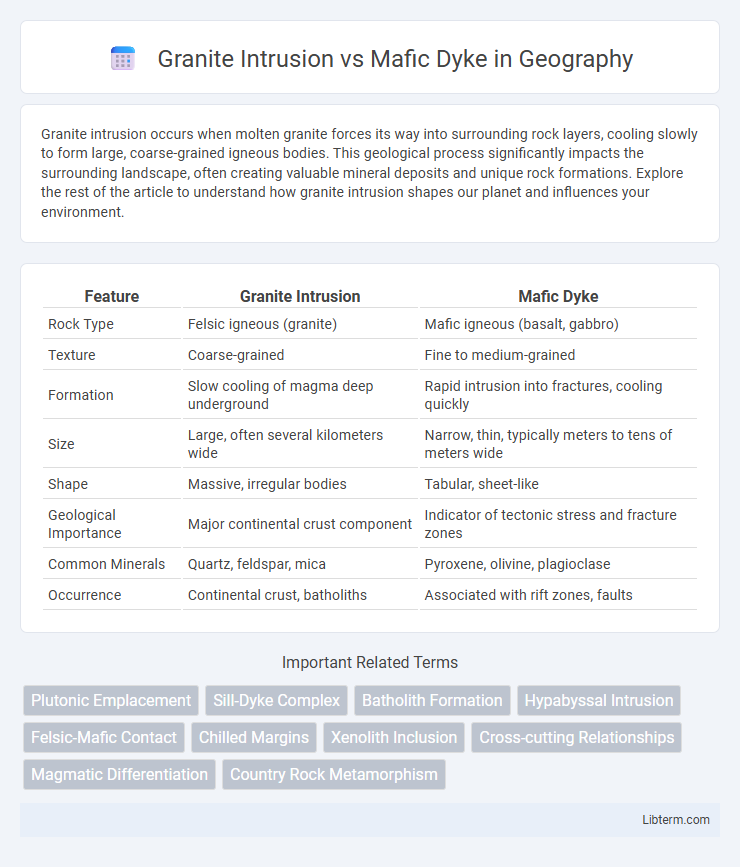Granite intrusion occurs when molten granite forces its way into surrounding rock layers, cooling slowly to form large, coarse-grained igneous bodies. This geological process significantly impacts the surrounding landscape, often creating valuable mineral deposits and unique rock formations. Explore the rest of the article to understand how granite intrusion shapes our planet and influences your environment.
Table of Comparison
| Feature | Granite Intrusion | Mafic Dyke |
|---|---|---|
| Rock Type | Felsic igneous (granite) | Mafic igneous (basalt, gabbro) |
| Texture | Coarse-grained | Fine to medium-grained |
| Formation | Slow cooling of magma deep underground | Rapid intrusion into fractures, cooling quickly |
| Size | Large, often several kilometers wide | Narrow, thin, typically meters to tens of meters wide |
| Shape | Massive, irregular bodies | Tabular, sheet-like |
| Geological Importance | Major continental crust component | Indicator of tectonic stress and fracture zones |
| Common Minerals | Quartz, feldspar, mica | Pyroxene, olivine, plagioclase |
| Occurrence | Continental crust, batholiths | Associated with rift zones, faults |
Introduction to Igneous Intrusions
Granite intrusions and mafic dykes represent two distinct types of igneous intrusions characterized by their composition and cooling history. Granite intrusions are coarse-grained, felsic bodies that crystallize slowly deep within the Earth's crust, forming large plutons such as batholiths and stocks. Mafic dykes are typically fine-grained, mafic intrusions that cut across existing rock layers, solidifying rapidly from magma that ascended through fractures or fissures.
Defining Granite Intrusions
Granite intrusions are large, coarse-grained igneous bodies formed from the slow cooling of silica-rich magma beneath the Earth's surface, typically creating plutons or batholiths. These intrusions exhibit a felsic composition, distinguished by high quartz and feldspar content, and are often associated with continental crust formation and mountain building processes. In contrast, mafic dykes are narrow, sheet-like intrusions of iron- and magnesium-rich magma that solidify rapidly, displaying a fine-grained texture and cutting across pre-existing rock layers.
Characteristics of Mafic Dykes
Mafic dykes are tabular, discordant igneous intrusions composed predominantly of mafic minerals such as pyroxene and amphibole, resulting in a dark, fine- to medium-grained texture. These dykes often cut across pre-existing rock structures, including granite intrusions, and form from basaltic magma that cools quickly, leading to their characteristic sharp contacts and linear patterns. Their composition contrasts with granite intrusions, which are felsic, coarse-grained, and typically form large, plutonic bodies through slow cooling deep in the Earth's crust.
Formation Processes: Granite vs Mafic Dyke
Granite intrusions form through slow crystallization of magma deep within the Earth's crust, resulting in coarse-grained, felsic rock rich in quartz and feldspar. Mafic dykes, by contrast, develop when basaltic magma rapidly intrudes and solidifies in fractures, producing fine-grained, iron- and magnesium-rich igneous rock. The contrasting cooling rates and chemical compositions govern the distinct textures and mineral assemblages defining granite intrusions versus mafic dykes.
Mineral Composition Comparison
Granite intrusions predominantly consist of quartz, feldspar, and mica, characterized by a high silica content and felsic mineralogy. Mafic dykes contain minerals such as pyroxene, olivine, and plagioclase feldspar, exhibiting low silica content with a mafic composition rich in iron and magnesium. The contrasting mineral assemblages highlight the felsic nature of granite intrusions versus the mafic signature of dykes, influencing their texture, color, and geological formation processes.
Textural Differences Between Granite and Mafic Dykes
Granite intrusions exhibit coarse-grained, phaneritic textures characterized by interlocking quartz, feldspar, and mica crystals formed during slow cooling deep underground. Mafic dykes display fine-grained to aphanitic textures, often with a glassy or crystalline structure due to rapid cooling near the surface and predominance of pyroxene and amphibole minerals. Textural differences reflect their cooling rates and mineral compositions, influencing their overall appearance and structural integrity in igneous rock formations.
Geological Settings and Occurrences
Granite intrusions predominantly form in continental crust settings associated with convergent plate boundaries or continental collision zones, where partial melting of crustal rocks generates felsic magma that solidifies at depth. Mafic dykes are typically emplaced in extensional tectonic environments such as rift zones or continental margins, where mantle-derived mafic magma exploits fractures to intrude into the surrounding rock. Granite intrusions occur as large plutonic bodies like batholiths, while mafic dykes are narrow, tabular bodies cutting through older rocks, reflecting differences in magma composition and emplacement processes.
Structural Relationships in the Field
Granite intrusions typically form large, discordant bodies that cross-cut existing rock structures, often exhibiting contact metamorphism effects, while mafic dykes are narrow, planar intrusions that exploit fractures and joints, displaying concordant or discordant relationships. Structural analysis shows granite intrusions cause significant deformation halos and thermal aureoles, whereas mafic dykes, due to their slender geometry, tend to have limited thermal impacts but highly control local fracture patterns. Field evidence highlights that granite intrusions can intrude earlier structural fabrics, while mafic dykes may post-date and truncate these fabrics, aiding in relative timing and tectonic history reconstruction.
Economic Significance and Applications
Granite intrusions are economically significant for hosting valuable mineral deposits such as tin, tungsten, and rare earth elements due to their prolonged cooling and mineralizing processes. Mafic dykes, often associated with nickel, platinum group elements, and copper sulfide mineralization, serve as important exploration targets in layered mafic-ultramafic complexes. Both geological formations play crucial roles in mining industries by providing essential resources for metallurgy, electronics, and construction sectors.
Summary: Key Differences and Implications
Granite intrusions are coarse-grained, felsic igneous bodies formed deep within the crust, characterized by high silica content and slow cooling rates, whereas mafic dykes are fine-grained, dark-colored, mafic igneous sheets that cut through existing rock formations, cooled rapidly near the surface. The key differences lie in their mineral composition, texture, cooling history, and emplacement environment, influencing their physical properties and geologic significance. Understanding these distinctions aids in interpreting tectonic settings, magma evolution, and associated mineralization processes in geological studies.
Granite Intrusion Infographic

 libterm.com
libterm.com